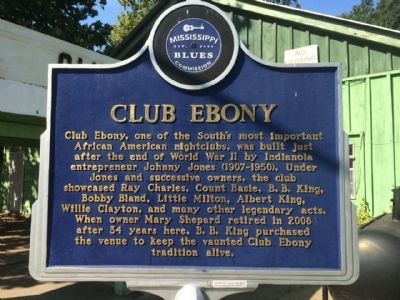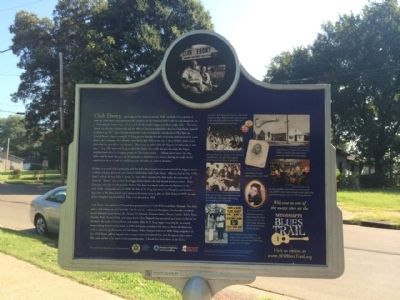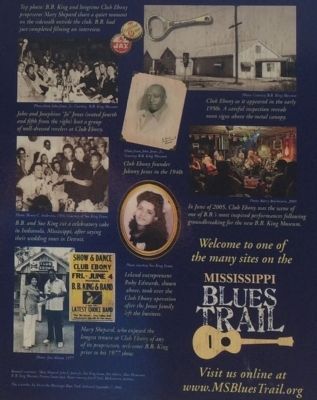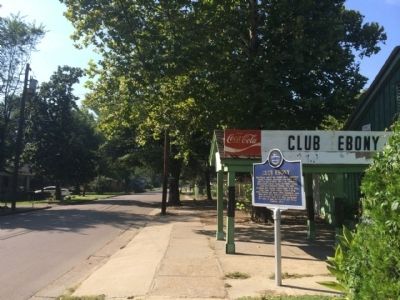Indianola in Sunflower County, Mississippi — The American South (East South Central)
Club Ebony
Front
Club Ebony, one of the South’s most important African American nightclubs, was built just after the end of World War II by Indianola entrepreneur Johnny Jones (1907-1950). Under Jones and successive owners, the club showcased Ray Charles, Count Basie, B. B. King, Bobby Bland, Little Milton, Albert King, Willie Clayton, and many other legendary acts. When owner Mary Shepard retired in 2008 after 34 years here, B. B. King purchased the venue to keep the vaunted Club Ebony tradition alive.
Rear
Club Ebony, which opened for business around 1948, was built over a period of years by John Jones, who purchased this property in November of 1945 with his wife Josephine. In a 1948 memoir, Jones wrote: “It is said to be the South’s largest and finest night club.” The name Ebony was already a fashionable one for African American nightclubs; the first Club Ebony opened in Harlem in 1927. Jones had operated other clubs in Indianola, notably Jones Nite Spot on Church Street, where a young B. B. King peered through the slats to witness performances by Louis Jordan, Jay McShann, Pete Johnson, and Sonny Boy Williamson No. 2 (Rice Miller). Jones wrote that when he opened his first business, “there were no other clubs for Negroes in Indianola at that time.” In a 1967 interview King recalled that Jones “was really the guy that kept the Negro neighborhood alive, by bringing people in, like Louis Jordan . . . Johnny Jones was a very nice fellow, and he knew the guys on the plantations didn’t have any money during the week, but he would often let us in and we would pay him off when we came in Saturday.”
Perhaps as a result of his generosity and the hefty fees he paid to present some of the biggest names in blues and jazz, Jones ran into financial difficulties with Club Ebony. After he died in May 1950, Jones’s widow, his son, John E. Jones, Jr., and others operated the club under the ownership of James B. “Jimmy” Lee, a white bootlegger from Leland who had loaned money to Jones. Ruby Edwards, who also ran the popular Ruby’s Nite Spot in Leland, took over the business in the mid-1950s, and purchased it in 1958. By then B. B. King had moved to Memphis and become a big name in the blues world; on a return to his home town to play at Club Ebony in 1955, he met Ruby’s daughter Sue Carol Hall. They were married in 1958.
Club Ebony was rented in 1974 and then purchased in 1975 by Willie and Mary Shepard. The club’s policy of booking top acts from the “chitlin circuit” continued throughout the decades: its talent roster included James Brown, Ike Turner, Syl Johnson, Clarence Carter, Denise LaSalle, Bobby Rush, Howlin’ Wolf, Tyrone Davis, and many more. Mary Shepard also presented local blues by David Lee Durham, the Ladies Choice Band, and others. After B. B. King began returning for an annual homecoming festival in his honor in 1980, it became a tradition for him to climax the festivities with a nighttime performance at Club Ebony. When Shepard retired in 2008, King stepped in to buy Club Ebony, preserving not only a major cultural landmark but also the special place where, fifty years earlier, as he wrote in his autobiography, "I found love back down in the Delta."
Erected 2009 by the Mississippi Blues Commission. (Marker Number 84.)
Topics and series. This historical marker is listed in these topic lists: African Americans • Arts, Letters, Music • Entertainment. In addition, it is included in the Mississippi Blues Trail series list. A significant historical month for this entry is May 1950.
Location. 33° 26.86′ N, 90° 38.878′ W. Marker is in Indianola, Mississippi, in Sunflower County. Marker is at the intersection of Hannah Avenue and Clay Street, on the right when traveling south on Hannah Avenue. Touch for map. Marker is at or near this postal address: 404 Hannah Avenue, Indianola MS 38751, United States of America. Touch for directions.
Other nearby markers. At least 8 other markers are within walking distance of this marker. Church Street (approx. 0.2 miles away); Irene Magruder (approx.
0.2 miles away); Riley B. King (approx. ¼ mile away); Fannie Lou Hamer (approx. ¼ mile away); Albert King (approx. 0.3 miles away); Giles Penny Savers Store (approx. 0.4 miles away); Freedom School Bombing (approx. 0.4 miles away); Craig Claiborne (approx. half a mile away). Touch for a list and map of all markers in Indianola.
Also see . . . Mississippi Blus Trail. (Submitted on September 20, 2014, by Mark Hilton of Montgomery, Alabama.)
Credits. This page was last revised on August 30, 2017. It was originally submitted on September 20, 2014, by Mark Hilton of Montgomery, Alabama. This page has been viewed 506 times since then and 50 times this year. Photos: 1, 2, 3, 4. submitted on September 20, 2014, by Mark Hilton of Montgomery, Alabama. • Bernard Fisher was the editor who published this page.



